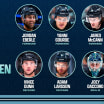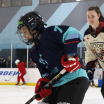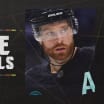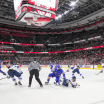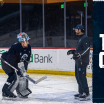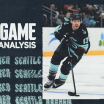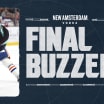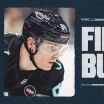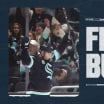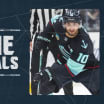Shane Wright is used to being under a microscope. At just 18 years old, he's accomplished the kind of things that bring such attention.
At age 15, he was the sixth-ever player to be given exceptional status by Hockey Canada, allowing him to play in the elite juniors Canadian Hockey League as an underage player. He played his first season in the Ontario Hockey League (OHL) with the Kingston Frontenacs in 2020. He was already being tossed around as the first overall Draft pick in 2022.
The Wright Way
Shane Wright is on his own path in the NHL, one that doesn't have to follow anyone else's
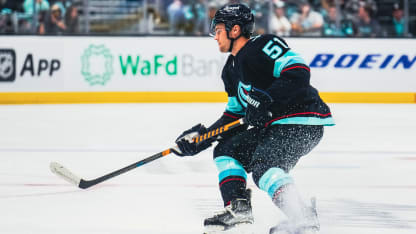
After being selected fourth overall this past July by the Kraken, Wright came to Seattle, signed his entry-level contract with the club, and was on the team's opening night roster. Now seven games into the NHL season, the center has played five games averaging 6:50 of ice time per game and someone who was already a hot topic of conversation has the spotlight shining a little bit brighter.
So, what is the thought process behind Wright's entry into the NHL?
"Everybody saw where [Wright] was ranked the last three years," general manager Ron Francis said. "You saw what happened at the draft and everybody is probably of the mindset he's going to come in and light the league on fire and it's going to be easy for him. But, [the NHL] is a good league. It is tough to do that. I would say enjoy the process with him. He's a terrific kid and he's going to be a great player for us for a long time. It's just a matter of us making sure we manage that the right way."
Wright's journey presents a unique set of options for the Kraken. Since the center was drafted out of the CHL, the only place Wright can play other than in Seattle, per the terms of a long-standing agreement between the two leagues, is in the CHL.
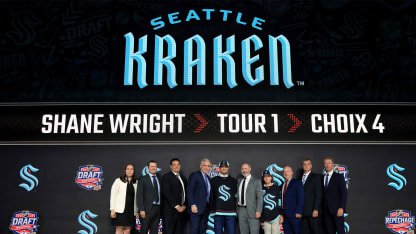
Unlike this year's second-overall pick, Simon Nemec, drafted from Europe, can - and is -assigned to the AHL. Third overall 2022 pick, Logan Cooley, like Matty Beniers last year, took the option to honor his commitment to Division I NCAA (University of Minnesota) to play against "bigger, stronger guys," as Francis describes. Wright's only paths are the NHL or a return to the CHL where he's already played three seasons.
Coming to the NHL means there's a lot to learn.
Wright is being exposed to systems he's not seen before. Even skills like faceoffs and taking pucks off the wall demand more of a player at the NHL level. That shift is not something lost on Wright's parents, Tanya and Simon. The couple was in Seattle for the first two home games of the Kraken season.
"Everybody tells you 'You know what, the NHL is a different level and you have to earn it,' and now I get it," Simon Wright said. "Now that I've watched some [NHL] games in person, the gap and the caliber of hockey between the [NHL and CHL] is a lot more significant. It's so much more significant than I ever thought ... just the caliber of hockey, and I'm thinking to myself, 'holy crap, my 18-year-old son is playing with these guys."
While Francis and the hockey operations group and coaching staff focus on communicating with Shane and building the player's skill set on the ice to bridge that gap, the young parent's center see a whole other evolution that's underway in their son who, never having lived on his own before, has moved across the continent to follow his dream.
Tanya describes both Shane and his sister, Maddie, as "very, very independent," but voices this challenge is on a whole new level. Now her youngest is learning how and where to do laundry; how to spend his free time away from the rink (he'd always had school responsibilities before); even how to get from here to there without a car at his disposal, "the Uber bill showed up at my house," Simon joked.
"The biggest adjustment is off the ice," Simon said. "You get on a plane, and you fly to a destination, for example, for an away game, and it's like 'what do I do with my time when I'm not playing hockey?' I think it's that adjustment that he's learning about as well. And it's part of being a pro at the end of the day, right?"
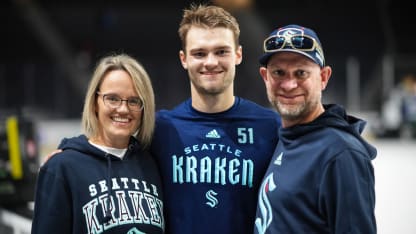
Wright recently bought a guitar to play. He's had one back at home but wanted to have one here in Seattle. He's enjoyed sushi dinners and golf with teammates.
"He's just absorbing [the hockey] and watching what pros do in their spare time," Tanya said.
Filling up time. That's been a big question around Shane on the ice, too. Both Francis and head coach Dave Hakstol have expressed the need to get the six-foot forward more ice time. As Francis says six to seven minutes of play, "is not ideal." The organization is striving to get him closer to the 10 to 12 minutes of play per game.
That was something Hakstol addressed head on after Shane scored his first point in the Oct. 19 game versus St. Louis.
"He's a good player, he's growing, he's heading in the right direction," Hakstol said. "Getting the point is a nice step. And you can see the confidence building ... I've got to get him on the ice for a couple more minutes and just continue to let him grow."
Where will that time come from? While Wright saw some time on the power play during training camp, the two units as currently designed are running at a 28.6 percent success rate (top 10 in the NHL) and that's not something to tinker with. The goal is to look for more minutes at even strength (5-on-5) while putting thought into which games are the best opportunities for Wright's success. Home matchups obviously give the coaching staff more control over who faces off against whom and managing time across all the forwards on the roster is a factor.
"We've got a good plan moving forward," Hakstol said. "It's all about making small progress. There are no big, huge leaps and bounds that we're looking for. We're looking for great work and slow progress and continued progress. That's the biggest thing for us."
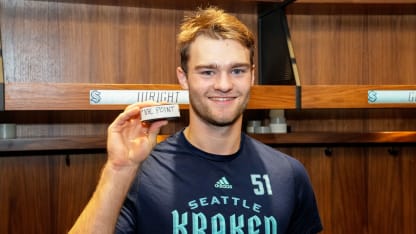
There have been moments when Wright isn't in the lineup that have been just as special…when the spotlight on Wright being less bright is a benefit.
At the home opener, Wright joined his parents at their seats at Climate Pledge Arena to soak up the atmosphere. A few fans started to realize who he was and asked for a photo, but otherwise the player was able to enjoy almost complete anonymity while sharing a moment with his family. That wasn't lost on Tanya and Simon, who are aware of the pressure that an 18-year-old in Wright's situation can face. For them, the existence of space for their son to be himself is just as important to how Wright can develop as is his understanding of the X's and O's of the game.
"He has a little bit of room to be a normal person just walking down the streets," Simon said. "It's a really cool balance here. But with unbelievable fans as well, it's really, really awesome."
Of course, it's too early to predict what the rest of the season will bring for Wright.
Any CHL player has the option in his first year of NHL action to play in a maximum of nine games before the first year of his contract goes into effect. Should the player play 10 or more games, they can always be returned to the CHL but the contract terms and compensation remain.
Other players have split seasons between NHL and CHL play including Edmonton's Leon Draisaitl who was traded to a top team in the league and subsequently named MVP of the Memorial Cup championship game.
"Ultimately it comes down to the player himself, the organization that he's in and what you're trying to do," Francis said. "Do we help that development more by keeping him here and working with him? And by January, do we have a better player than we had in October? I hope so. And by April that we have a better player than we had in January. I hope so again.
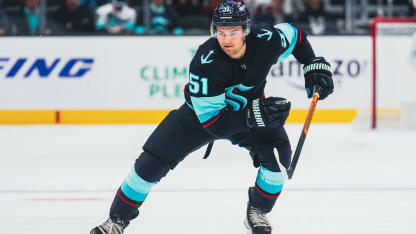
"If we send him back [to the CHL], there's a chance at some point he is traded and then he's on a team that's competing for the Memorial Cup. Is that better for him? There's a lot of factors that we look at and try and sort through. Right now, we're going to take it a day at a time and watch how he does and how he responds and see how we progress here."
Whatever happens, no one is doubting the player. His mom has seen the journey Wright has been on and it never fails to impress her. Watching him do post-game media recently had her gushing about the confidence and humility she saw in her son while, at the same, being so excited for the player he will become.
That's an opinion his general manager shares.
"The player you see at 18 [years old] is not the player that you're going to see at 23 [years old]," Francis said. "It's the process of getting him along there with maintaining the confidence in his abilities and his talent. It's staying positive with him and talking to him; explaining that we're not judging his games on the number of goals and assists he puts up. It's how he plays shift in and shift out and the effort and what he's learning and what he's incorporating that he's been learning into those games. That's more of a priority at this point.
"He sees the game extremely well. He's got a really good skill set. It's getting that comfort level in his game. This is the best league in the world and he's 18 years old playing in it. That's as young as you can get. It's just going to be a process to help with that maturity."
Can the Kraken be the franchise to help Wright do all that? Those who know the player the best think so.
"I have trust in the entire organization," Simon said. "Whether that's ownership through to Ron Francis to the coaching staff and then through all the support staff. We've had countless interactions with different individuals throughout the organization at different levels and it's all been unbelievable. . .just even having simple conversations with Shane and what his thoughts are. We have nothing but faith trust and belief in the Kraken organization."

